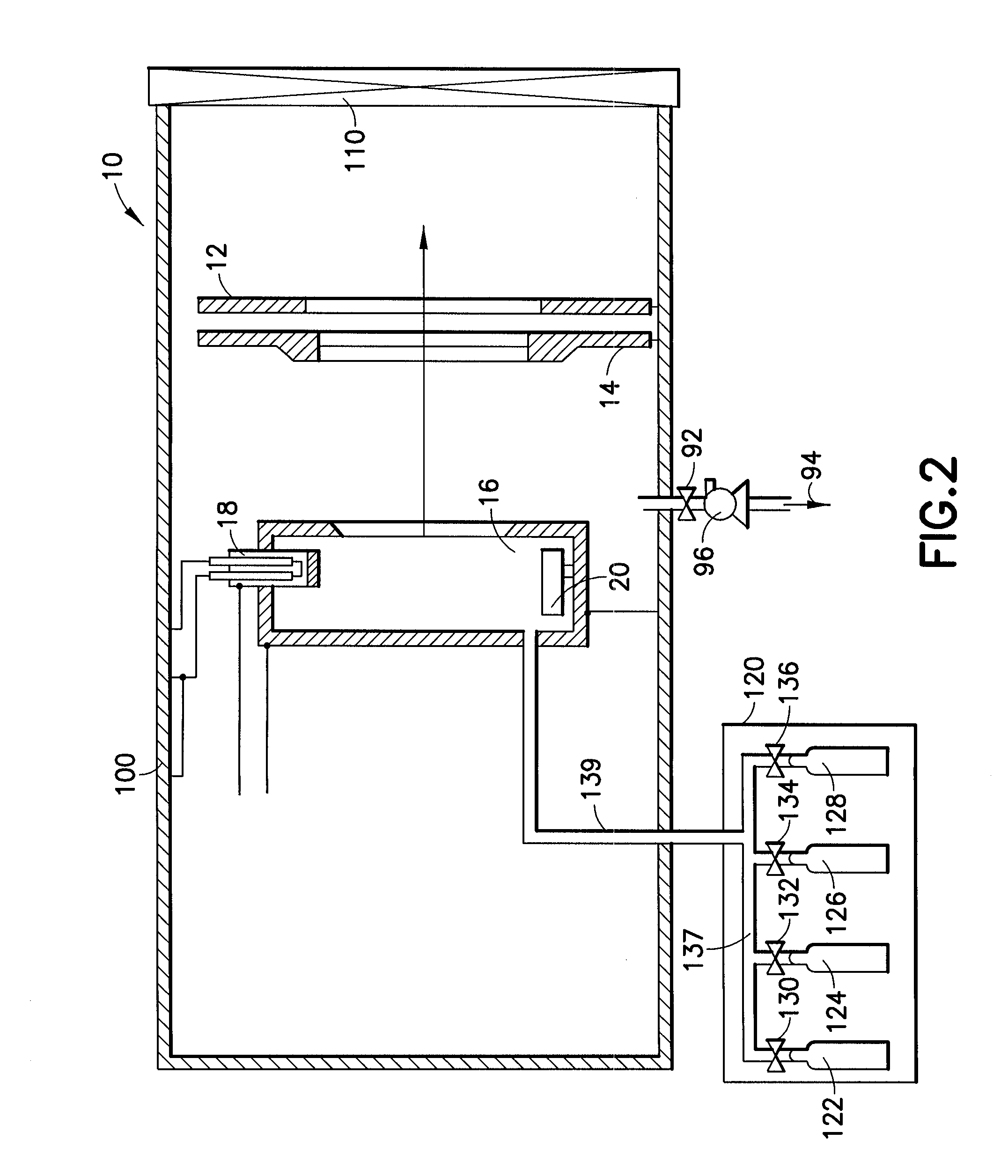Cleaning of semiconductor processing systems
a technology for processing systems and semiconductors, applied in vacuum evaporation coatings, cleaning of hollow articles, coatings, etc., can solve problems such as electrical short circuits, system filaments that can require replacement, and ion source deposition and contamination
- Summary
- Abstract
- Description
- Claims
- Application Information
AI Technical Summary
Benefits of technology
Problems solved by technology
Method used
Image
Examples
example 1
[0237]Test samples were prepared using electron beam deposition of aluminum, boron, tungsten and silicon on glass microscope slides. The aluminum was used as a bottom layer barrier on the glass slide. Some samples were capped with a protective silicon layer while others were left uncapped and allowed to oxidize. The test samples were sequentially placed into an ex situ XeF2 reactor, of a type as shown and described with reference to FIG. 4 hereof, and etched for 16 one-minute pulse-etch cycles at a pressure of 300-400 mTorr at room temperature.
[0238]FIG. 5 is an RGA trace as a function of time showing the efficacy of XeF2 in removing boron residue from an aluminum base layer. The pulse-etch cycles are shown by peaks in the RGA pressure plot in FIG. 5.
[0239]The RGA determined the removal of boron from a glass slide having a base layer of 500 nm of aluminum with 500 nm of boron deposited thereon. There was no silicon capping layer, and therefore the boron could have potentially formed...
example 2
[0242]FIGS. 7 and 8 show data taken on an ion source test apparatus including a single filament Bernas Source with molybdenum arc chamber, and an 80° analyzing magnet with faraday cup measurement of the analyzed beam. A cylinder of XeF2 operating at ambient temperature was installed in the gas box and connected to the ion source with a conventional high conductance gas line.
[0243]FIG. 7 is a graph of beam current, in mA, as a function of time, showing the use of XeF2 plasma to improve stability of the ion source. The source was run with BF3 plasma for about 12 hours at its beam current specification limit, which corresponds to an analyzed beam of about 10 mA of 11B+. When the beam current measurements shown in FIG. 7 began, the source exhibited severe instability at 50 kV extraction voltage, and this instability was not significantly improved by reducing the voltage to 40 kV. After running XeF2 plasma for 20 minutes, the source ran unexpectedly much more stably for about two more ho...
example 3
[0246]While the above Example 1 shows non-reactivity of XeF2 with tungsten on aluminum on a glass slide, it has been found that for an operational ion implantation system, XeF2 is an effective cleaning agent of tungsten deposits generated by reaction of the system components (specifically the arc chamber) with the fluorinated feedstock gas.
[0247]A Bernas source was operated with BF3 feedstock at maximum B+ beam current for 52 hours. The source was removed and two alumina repeller insulators, coated with deposits were removed. Both insulators were weighed prior to cleaning. Insulator 1 (bushing) weighed 6.1676 g prior to cleaning and Insulator 2 (spacer) weighed 7.0662 prior to cleaning. The two insulators were placed in an ex situ vacuum chamber and were cleaned using eleven fill / vent cycles with XeF2, at pressures up to about 3 torr. Each cycle lasted approximately 10 minutes. The mass of XeF2 used in each cycle was about 0.10 g.
[0248]While the cleaning cycles were performed, the R...
PUM
| Property | Measurement | Unit |
|---|---|---|
| threshold level | aaaaa | aaaaa |
| threshold level | aaaaa | aaaaa |
| temperature | aaaaa | aaaaa |
Abstract
Description
Claims
Application Information
 Login to View More
Login to View More - Generate Ideas
- Intellectual Property
- Life Sciences
- Materials
- Tech Scout
- Unparalleled Data Quality
- Higher Quality Content
- 60% Fewer Hallucinations
Browse by: Latest US Patents, China's latest patents, Technical Efficacy Thesaurus, Application Domain, Technology Topic, Popular Technical Reports.
© 2025 PatSnap. All rights reserved.Legal|Privacy policy|Modern Slavery Act Transparency Statement|Sitemap|About US| Contact US: help@patsnap.com



